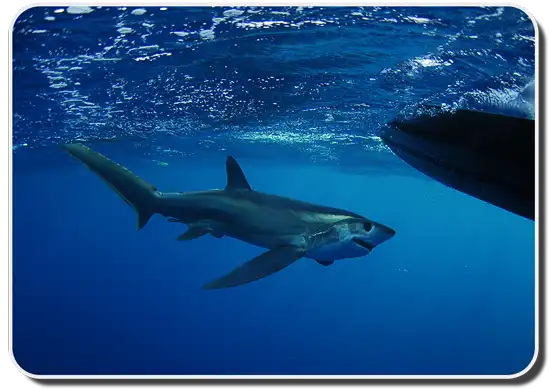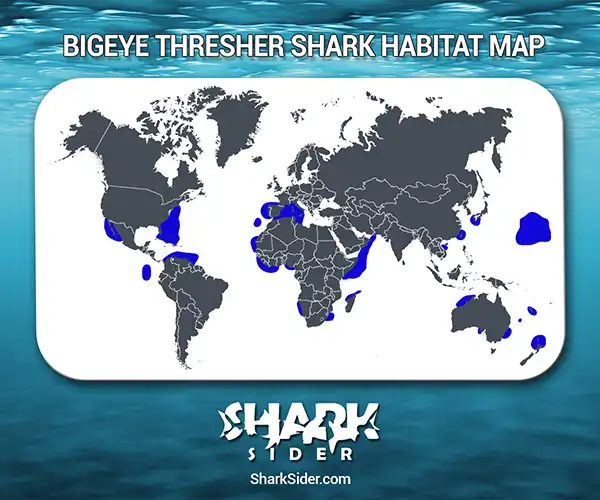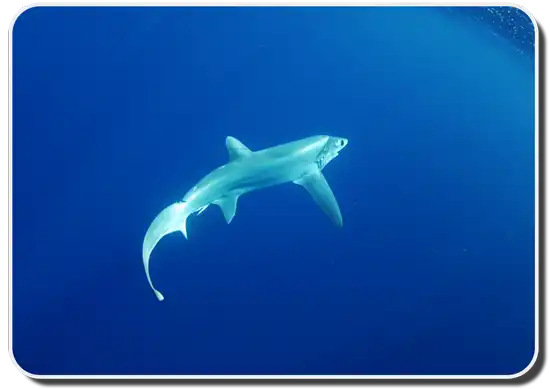Named after its huge eyes present in keyhole-like sockets, the bigeye thresher shark is distributed throughout temperate and tropical oceans globally.

Bigeye Thresher Shark Scientific Classification |
|
| Kingdom | Animalia |
| Phylum | Chordata |
| Class | Chondrichthyes |
| Order | Lamniformes |
| Family | Alopiidae |
| Genus | Alopias |
| Scientific Name | A. superciliosus |
Description
Bigeye threshers are 10.8–13.1 ft long and weigh about 350 lb. Currently, the record for the largest shark of this species is held by a specimen captured in February 1981 close to Tutukaka, New Zealand, which was 16 ft long and weighed 802 lb.
The head of this shark has the characteristic “big eyes” about 3.9 inches, as well as a pair of distinct grooves from the eyes to the gill slits that look like a helmet. Their snout is long and bulbous, dermal denticles are all over their bodies, and moderately large teeth are in both jaws. There are 19–24 rows of teeth in the upper jaw and 20–24 tooth rows in the lower one.
Similar to other thresher sharks, they have a vast, sickle-shaped caudal fin which is half the length of the shark’s entire body. Besides, they have a set of curved pectoral fins and a first dorsal fin much lower down than in other thresher sharks.
They range from metallic violet to purplish brown when looked at from above and appear creamy white from below.
Where do they live
Map Of The Bigeye Thresher Shark’s Habitat

Bigeye threshers have been spotted throughout the world’s oceans. In the Atlantic, their range encompasses Angola, Florida, Guinea, Madeira, New York, Portugal, Senegal, Sierra Leone, southern Brazil, the Caribbean, the Mediterranean Sea, Tobago, and Venezuela; in the Indian Ocean, it is seen in Madagascar, South Africa, and the Arabian Sea and in the Pacific, they are seen eastward to Hawaii, New Caledonia, New Zealand, northwestern Australia, southern California and Japan, Taiwan, the Gulf of California, and west of the Galapagos Islands.
Behavior
Hunting
Their diet includes fish like bullet tuna, hake, herring, lancetfish, mackerel, small billfish, and whiting, as well as crabs and squids. These sharks use their tails to stun potential prey before devouring them. Certain reports indicate that this thresher shark uses its tail to stun birds out of the air.
Migratory
Bigeye threshers undergo a diel vertical migration, staying at depths of 980–1,640 ft during the day to hide from threats and surfacing at night to feed.
Reproductive
They are ovoviviparous, giving live birth to two pups, though sometimes there can be one, three, or four in a litter. Initially, the pups are 4.4–4.6 ft long. The males become sexually mature at 9-10 years and lengths of 8.9–9.5 ft, while the females do so when they are 12–14 years old and 11–12 ft long.
Males can live up to 19 years, and females have a lifespan of 20 years.

Adaptations
The large eyes of this shark give it an excellent vision, even in low light conditions. Like other thresher sharks, they have powerful tails that stun prey and potential predators.
Interactions with humans
This shark infrequently interacts with humans and isn’t considered a threat. It is often caught as bycatch worldwide by both longline fisheries and trawls. While its meat is not of high value, its liver is processed for its oil, the fins for shark fin soup, and the skin is used in leather products.
As this species has a low reproductive rate and is at risk from fishing activities, the IUCN has classified it as “Vulnerable” or “VU”.
